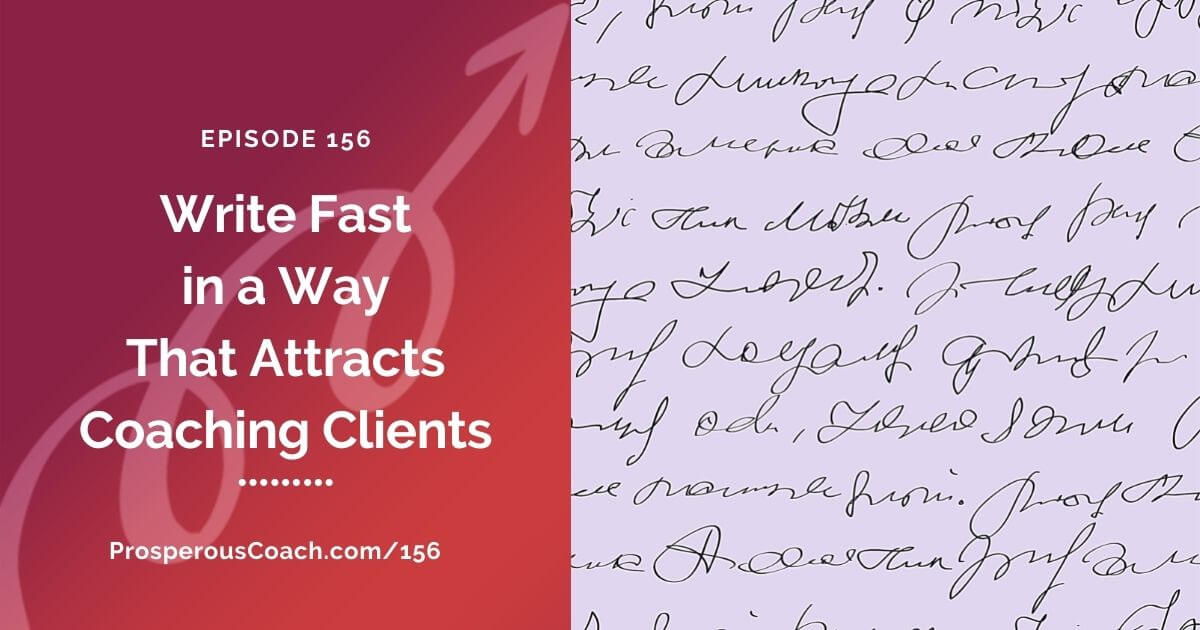If writing for your business is your nemesis or you just wish it wouldn’t take so long, this episode is for you.
Also as a bonus to help you write more effectively grab your copy of my free downloadable guide called 5 Rules to Write Better Copy.
You know this … writing well is one of those skills that can catapult your business into a more profitable gear. If you can learn to write in a way that your audience wants to read, you can:
- write and publish your own books
- develop online training programs
- publish a weekly blog
- post articles on well known platforms
- create excellent scripts for your podcast
- write better presentations, lead magnets and guides
And all of that would help you attract and enroll more high paying clients and earn in other ways too.
But for most coaches I meet they say that writing doesn’t feel easy and it’s so time consuming. One of my clients told me that it takes at least one full day to write a blog post. And I remember taking that long when I first started writing.
Here’s the thing … writing is easily mastered with a few tools in your toolbox.
You Are a Better Writer Than You Think, Coach
And, of course, it’s part mindset. Some of my clients tell me they are not good at writing. Inevitably, I disagree! I love helping my VIP clients learn how to write even better and it’s fun for me to copyedit and give suggestions for all of their writing.
I find that they all very rapidly improve in their skills so they don’t need my edits any more.
The real issue is how long it takes to organize thoughts into a flow that inspires reading.
I was a passable writer when I was given the opportunity to write the curriculum for Coach Training Alliance. By the time I finished that project I was a far better writer and could write fast.
Surprise, surprise … writing more means writing more easily and better.
5 Secrets to Whittle Down Your Writing Time
- Know your key takeaway before you start writing.
- Keep your topic specific and bite sized.
- Use a formula for the flow of paragraphs.
- Set a timer to write, then another to edit.
- Go for good enough.
What’s Your Big Aha or Takeaway?
All writing should have a top takeaway. To impress your audience and show your value, provide one well formed and unique aha, insight or tip. Don’t start writing until you’re crystal clear about what that is.
And one is all you need. The biggest mistake writers make is delivering too much at one time. I delivered my top takeaway for this episode in the 5 secrets just named. Now, I’m going to flesh it out a bit more for you.
The Strategic Writing Formula
When you write your blog or notes for your podcast your goal should be to inspire, guide and entertain your audience on a bite-sized topic that’s important to them. That’s called generosity marketing and it’s how you’ll create followers.
Followers become dedicated clients and referral sources.
Use this basic formula:
- Connect and introduce — Introduce your topic in 1 – 3 short paragraphs. Lead your audience in by contextualizing the scenario to them. Show you understand them.
- Present their specific problem — In 1-2 short paragraphs present the specific problem you’re addressing. It must be something real and acute for your audience.
- Share your original solution to the problem – In 1 sentence share your specific aha or tip as it relates to the problem in a way that will open their eyes, show your insight and inspire deeper reading.
- Provide more value – In 5 – 10 short paragraphs flesh out and illustrate your solution.
- Invite transformation – In a final paragraph summarize and invite them to try on a new mindset or take action in a simple way related to your topic.
So when you first conceive of an idea to write about, you want to jot some quick notes for each of the 5 sections above that I just mentioned. And then you want to set a timer for 30 minutes — just 30 minutes. And write without editing. Get the thoughts down.
Then, take a break. You know, get up, walk around, take a walk with the dog. Whatever you do take enough of a break so you relax a little bit. When you come back read your whole article — or whatever it is — out loud. Reading out loud is really helpful.
And then, notice, as you’re reading it out what needs improvement. You might even notice typos or extra spaces, or something like that, that you can correct quickly.
Then set the timer for 30 more minutes and edit. You might do these things:
- You might rearrange sentences or paragraphs for the most ideal flow.
- Remove unnecessary words and prepositional phrases.
- Streamline paragraphs to less than 3 lines or break them into two paragraphs.
When that timer goes off stop editing and take a break.
When you come back read the whole article out loud again. Take no more than 10 minutes to proof, spellcheck and give it a curiosity raising title that has keywords for your audience. You are done! Remember, go for good enough not perfect. No one really wants perfect. They want relatable.
I shared these secrets and tips with one of my VIP clients recently and she was able to reduce her time writing by more than half the next time she wrote. I bet she’ll be able to whittle it down to half of that again next time.
Don’t forget to grab my bonus for you — 5 Rules to Write Better Copy — a free downloadable guide for you. Snap that up and you’ll be a better writer soon!

